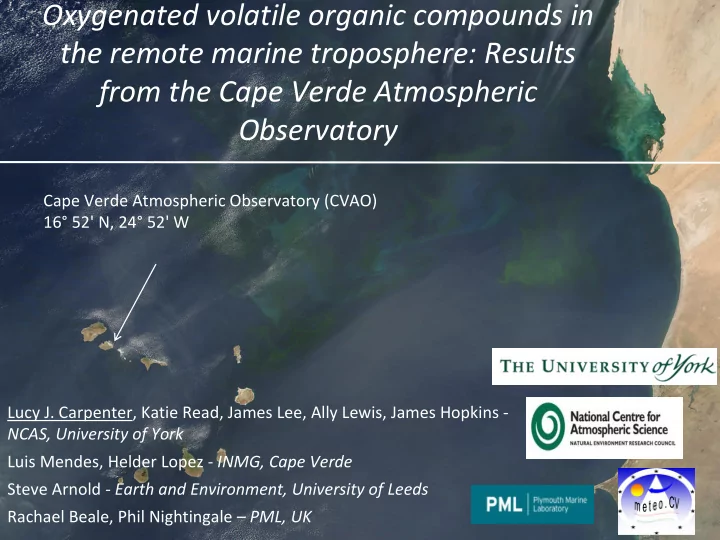

Oxygenated volatile organic compounds in the remote marine troposphere: Results from the Cape Verde Atmospheric Observatory Cape Verde Atmospheric Observatory (CVAO) 16° 52' N, 24° 52' W Lucy J. Carpenter, Katie Read, James Lee, Ally Lewis, James Hopkins ‐ NCAS, University of York Luis Mendes, Helder Lopez ‐ INMG, Cape Verde Steve Arnold ‐ Earth and Environment, University of Leeds Rachael Beale, Phil Nightingale – PML, UK
Measurement Method Met stations at 10, 30m Various O 3 UV absorption NO/NOx/NOy Chemiluminesence CO VUV Fluorescence C 2 -C 8 NMHCs and DMS dc-GC-FID C 1 -C 5 O-VOC dc-GC-FID Halocarbons GC-MS JO 1 D Radiometer
Oxygenated volatile organic compounds (OVOCs) OH loss in marine Atmospheric OVOCs boundary layer Methanol Ocean: source or sink? Anthropogenic and N biomass burning sources Cape Verde Atmospheric NO 2 PAN h , O 2 , OH Observatory (CVAO) Acetone CH 3 C(O)O 2 Biogenic sources HO 2 organic acids h , O 2 , OH HCHO, HO x , CH 3 O 2 Primary and secondary sources Source of HO x , O 3 and PAN Acetaldehyde
CAM ‐ Chem vs measurements acetone (ppt) Monthly averages Dominated by anthropogenic emissions (39 % ‐ 91 %)?
Are MBL acetone concentrations controlled by anthropogenic NMHC? 10000 1000 acetone (pptV) 100 propane (ppt) 10 10 100 1000 propane ( pptV)
OVOC Water Measurements Role of the oceans? • Jacob et al. (2002) ‐ ocean a AMT track significant source of acetone • Methanol, acetaldehyde OVOC and acetone hv quantified in seawater via CDOM CDOM MI- PTR/MS o N Acetaldehyde in Mauritanian Upwelling (ICON) Filament 1 Filament 2 Acetaldehyde (nM) Latitude Days since patch initiation (T 0 ) o S Beale, R. Quantification of oxygenated volatile organic compounds (OVOCs) in Acetaldehyde (nM) seawater, 2011, Ph.D thesis, University of East Anglia, UK. Manuscripts in preparation.
Modelled oceanic acetone fluxes • Sea ‐ air flux F = k t ( C w – C a / H ) l/ k t = 1/ k w + 1/ Hk a
How does this change model results? 01/01/2007 20/02/2007 11/04/2007 31/05/2007 20/07/2007 08/09/2007 28/10/2007 2500 2500 10th ‐ 90th percentile range Mean (measurements) CAM ‐ Chem STD model 2000 2000 STD ‐ NOANTH STD ‐ NOBIO STD ‐ NOFIRE CAM ‐ Chem model with ocean acetone (pptV) 1500 1500 1000 1000 500 500 0 0 Jan Feb Mar Apr May Jun Jul Aug Sep Oct Nov Dec Cumulative LAI (m 2 m -2 )
Biological (terrestrial) influences
Could model bias be due to underestimated biogenic emissions? 3.5 y = 3.39x + 0.28 y = ‐ 3.08x + 3.44 y = 20.02x + 0.59 3.0 2 = 0.71 2 = 0.83 2 = 0.39 R R O b s e rv e d /m od e lle d R 2.5 2.0 1.5 1.0 0.5 0.0 0.00 0.10 0.20 0.30 0.40 0.50 0.60 0.70 0.80 0.90 1.00 Fractional contribution to acetone Fractional contribution from biogenic (green), anthropogenic (purple) and biomass burning (red) sources as calculated from CAM ‐ Chem. Grey lines indicate 1:1 observation:model agreement.
Methanol
Modification of atmospheric methanol by oceans
Acetaldehyde 10000 1000 acetaldehyde (pptV) 100 10 1 10 100 1000 propane (pptV)
Acetaldehyde modification by oceans
Impact of OVOCs on diurnal mean MBL [OH] OVOC concentrations from: (i)observations at Cape Verde (ii)monthly ‐ mean CAM ‐ Chem model output including ocean fluxes (iii)set to zero CittyCat box model simulations
Indirect Additional % contribution Reference from summer CO emission impact: OVOC sources not shared by ethane Methane oxidation 5 % (May-October) Granier et al., 2000 as sources of NMHC oxidation 12 % (May-October) Granier et al., 2000 20 % (June-November) Miller et al., 2008 Terrestrial oVOC CO oxidation Oceanic NMVOC 20 % (July-September) Guenther et al., 1995 oxidation Using nOH (fossil fuel and biomass) Using nOH (fossil fuel and biomass) 250 250 methane oxidation methane oxidation terrestrial nmhc oxidation (mainly isoprene) terrestrial nmhc oxidation (mainly isoprene) oceanic voc oxidation oceanic voc oxidation 200 terrestrial ovoc oxidation 200 terrestrial ovoc oxidation 150 150 CO (ppbV) CO (ppbV) 100 100 50 50 0 0 Oct/06 Dec/06 Jan/07 Mar/07 May/07 Jul/07 Sep/07 Nov/07 Jan/08 Mar/08 Oct/06 Dec/06 Jan/07 Mar/07 May/07 Jul/07 Sep/07 Nov/07 Jan/08 Mar/08
Conclusions • Oxygenated VOCs are a significant direct sink of OH in the MBL • Their abundance in the remote marine environment is underestimated (particularly CH 3 CHO) • Marine and biological terrestrial sources of OVOCs could explain some of this model underestimation – more work required to establish emission strength and variability • >C3 alkanes and alkenes – chemistry and emissions
Acknowledgements Funding: Technical support at CVAO: Luis Mendes Neves Helder Lopez
Modelled (GEOS ‐ 5) and measured wind speed • With a squared wind dependence for sea ‐ air fluxes, the difference between 10 m s ‐ 1 and 6 m s ‐ 1 is a factor ~3.
Recommend
More recommend